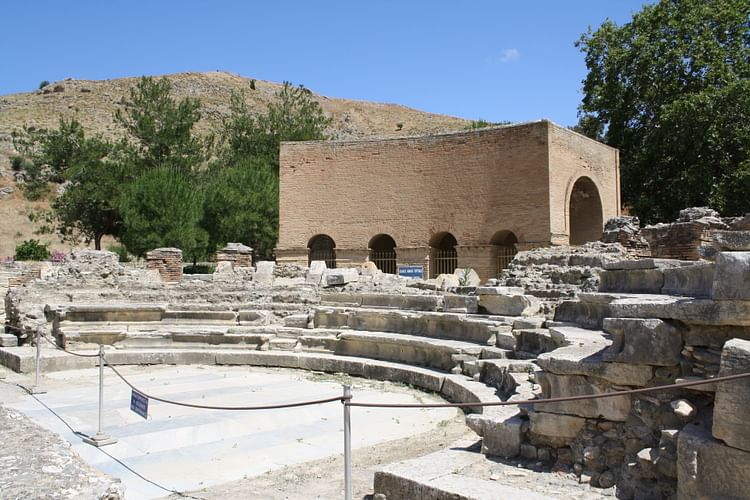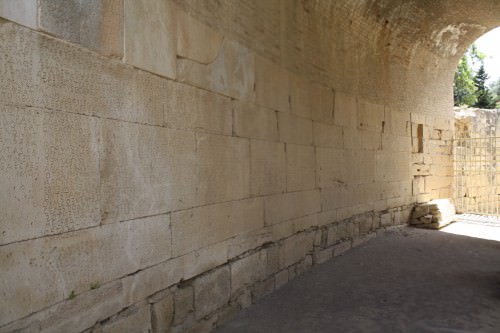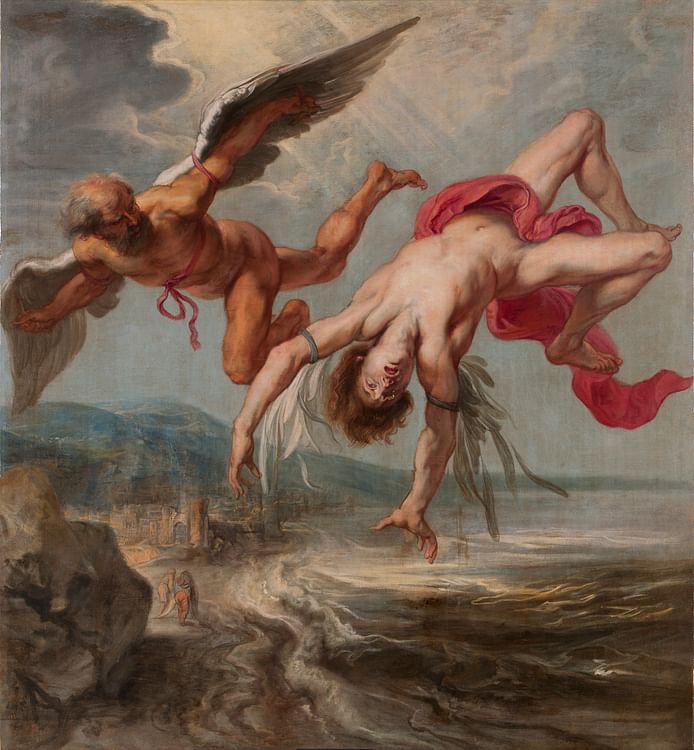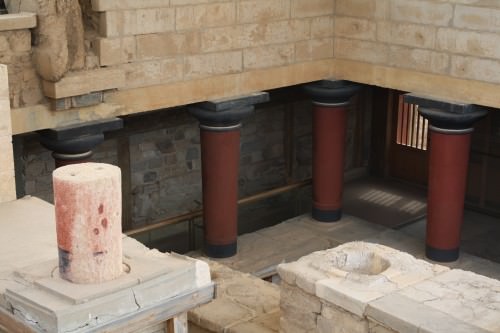Gortyn › Daedalus » Ancient origins
Articles and Definitions › Contents
- Gortyn › Antique Origins
- Daedalus › Who Was
Ancient civilizations › Historical and archaeological sites
Gortyn › Antique Origins
Definition and Origins

Gortyn is located on the Mesara plain of central Crete and was an important settlement throughout antiquity from the Minoanto Hellenistic periods. In Roman times the city went on to gain even more importance as the capital of the Roman province of Crete and Cyrene. The site today is particularly noted for the Gortyn Law Code, a lengthy wall inscription created in the 5th century BCE which is the earliest such example in Europe.
BRONZE AGE GORTYN
First settled in the Late Bronze Age, Gortyn was built on an acropolis and initially controlled by the Minoan palace of nearby Phaistos until it rose to prominence as the most important city-state in the region. Bronze Age Gortyn is also the setting of several important stories from Greek mythology. Europa was seduced here by Zeus when he took the form of a bull; their marriage taking place under an evergreen tree at the site. Gortyn is mentioned in Homer ’s Iliad as being a walled city and in the Odyssey where the Greeks, returning home from the Trojan War, are driven against the stormy coastline of southern Crete.
THE ARCHAIC PERIOD
In the 8th and 7th centuries BCE the city spread onto the plain near the Mylopotomos River. It was served by several nearby harbours, notably Matala and Lebena. The city acquired the usual agora, monumental sculpture and religious temples of a prosperous Greek polis or city-state. Two of the city's most important temples were dedicated to Apollo and Athena, the latter being regarded as the guardian of the city.
THE GORTYN LAW CODE IS THE EARLIEST SURVIVING LEGAL INSCRIPTION FROM ANYWHERE IN EUROPE.
THE CLASSICAL PERIOD & LAW CODE
Gortyn continued to flourish and created its own coinage from 470 BCE. Unfortunately, there are few remains of buildings from this period but there is one truly unique survivor. This is the famous Gortyn Law Code, which dates to c. 450 BCE.Inscribed on a curved porticus wall of marble blocks on the edge of the agora, this huge text spans 8 metres. It is divided into 12 columns and is in boustrophedon, that is alternate lines are read in opposite directions. The 600-line text, using the Doric alphabet and dialect, is almost complete and was clearly meant to be read by any member of the public. The Code describes articles of property and marital law, and is of special interest to historians for its details on the family and women's status. Also covered are rules concerning inheritance, debts, adoption, marriage, slavery, and sexual violence. It is the earliest surviving legal inscription from anywhere in Europe. Following the destruction of the supporting wall, the Code was actually dismantled and reassembled in the 1st century BCE. It was re-set in its original position although the communal space now functioned as a bouleuterion or meeting place for the city's council.

The Law Code of Gortyn, Crete
THE HELLENISTIC PERIOD
Gortyn continued to prosper in the Hellenistic period and, in the 3rd century BCE, it led a confederation of Cretan city-states against Knossos. Other indicators of Gortyn's increase in status included construction of an extra agora and a sanctuary to Demeter and Kore. With the support of Ptolemy IV Philopater of Egypt, Gortyn felt confident enough to take on rival Cretan powers such as Knossos and Phaistos in the Cretan Wars. Gortyn defeated Phaistos in the 2nd century BCE and then sided with old enemy Knossos to defeat Lyttos in c. 220 BCE.
THE ROMAN PERIOD
Rome began to take an interest in Cretan affairs in the 2nd century BCE, but Gortyn made the strategic error of giving sanctuary to Rome's great enemy Hannibal in 189 BCE. Then, switching policy and supporting Quintus Caecilius Metellus during his brutal invasion of Crete in the mid-1st century BCE, Gortyn seized the opportunity to increase its own power on the island and grow to an unprecedented size. The strategy worked as c. 27 BCE Augustus made Gortyn the capital of the Roman province Crete and Cyrene (in modern Libya).
Made the seat of the proconsul, the city also benefitted from a new complex for this purpose, the praetorium. Continuing to prosper in the following centuries the population grew to 300,000 and the city benefitted from Roman baths, theatres, a stadium, arena, odeion, and circus, as well as a much improved water system which included fountains, cisterns and aqueducts. A further indicator of Gortyn's status in the Roman world was the stationing of such prominent figures as future emperor Trajan, who served as the island's quaestor in 81 CE.
From the 3rd century CE Gortyn was involved in several episodes during the rise of Christianity, notably, in 249 CE when 10 Christian martyrs were killed in a nearby amphitheatre in a brutal wild animal hunt the Romans were so fond of staging. In 295-297 CE the province of Crete and Cyrene was divided and, although Gortyn remained the Cretan capital, it was now responsible to the prefect of Illyricum. The city fell into decline following a devastating earthquake in 365 CE after which it was abandoned as an administrative centre. Gortyn's fortunes did revive in the early Byzantine period with the construction of a new city further east where several basilicas were built, notably the 6th century CE Church of St. Titus (Hagios Titos), a follower of St. Paul who was martyred at the site. However, after another major earthquake in 670 CE Gortyn was definitively abandoned.
MAP
Daedalus › Who Was
Definition and Origins

Daedalus is a figure from Greek mythology famous for his clever inventions and as the architect of the Minotaur ’s labyrinthon Crete. He is also the father of Icarus who flew too close to the sun on his artificial wings and so drowned in the Mediterranean. By the Roman period, Daedalus had acquired a long string of accomplishments and he came to represent, in general, the supreme master craftsman. The myths of Daedalus appear in the works of such noted writers as Homer, Herodotus, Ovid, and Virgil.
ORIGINS
The ancient Greeks closely associated Daedalus (also spelt Daidalos) with the god Hephaistos, the genius craftsman of Mt.Olympus. It is possible that both figures have their origin in the Phoenician and Ugarit god Kothar, who was also considered a skilled artisan. In addition, it seems likely that highly valued artworks traded by the Phoenicians and reaching Greece, especially Crete, gave rise to myths concerning the fabled craftsmen of the Near East. Moreover, the very word daidalossignified 'finely-worked' and 'elaborate'.
CRAFTSMAN TO KING MINOS
In Book 18 of the Iliad, Homer mentions that Daedalus lived at Knossos on Crete and designed an open-air dance floor there for King Minos' daughter Ariadne. He is credited in later sources as offering his considerable skills for other projects on Crete, specifically, designing the wooden bull that Minos' wife Pasiphae used to capture the affections of the bull she was in love with, building Minos' palace, and constructing the labyrinth where the offspring of that union, the half man-half bull Minotaur, dwelt.The same sources also report that Daedalus made the thread which Ariadne gave to the hero Theseus so that he might kill the Minotaur and escape from the labyrinth.
IN ANTIQUITY, DAEDALUS WAS CREDITED AS THE CREATOR OF AN EVER-INCREASING NUMBER OF FABULOUS INVENTIONS & ARTWORKS.
DAEDALUS & ICARUS FLEE CRETE
Daedalus fell out of favour with King Minos, probably, and perhaps understandably, for the cow he had built Pasiphae, and he and his son Icarus were forced to flee for their lives. For this purpose, Daedalus constructed wings so that the pair might fly with ease from the wrathful king. Daedalus warned his son that for the wings to function best he should not fly too close to the sea lest the moisture render the feathers too heavy and useless, nor should he fly too high or the sun's heat would likewise damage the wings.
The young Icarus, alas, did not heed his father's advice and, on over-reaching himself and flying too close to the sun, the heat melted the wax which attached the wings to his arms. As a consequence, he plummeted into the sea and drowned in a tale that reminded of the folly of over-ambition. The tragedy was commemorated in the naming of the stretch of waters in that area the Icarian Sea, and then, when Hercules dragged the washed up body to an island, he re-named that place Icaria in honour of the fallen youth. The island still bears the name today and lies just south-west of Samos.

The Palace of Knossos
DAEDALUS ON SICILY
Meanwhile, Daedalus had made it safely to Sicily where he was looked after by King Cocalus (also spelt Kokalos). In gratitude to Hercules, Daedalus sculpted a fantastically life-like statue of the hero. Unfortunately, this statue came to an unfortunate end one night, when Hercules himself stumbled across it and, convinced by its realism, thought it an enemy and smashed it to pieces. At the same time, King Minos had not simply allowed his talented architect to escape scot-free and actually pursued him all the way to Sicily but upon landing the daughters of Cocalus boiled him alive in a steam bath. Daedalus soon gave Cocalus reason to be glad for his arrival as he continued to produce such masterworks as a golden ram (or honeycomb) for the temple of Aphrodite on Mt. Eryx, a fortress at Acragas ( Agrigento ), and a steam bath at Selinus ( Selinunte ).
THE LEGEND OF DAEDALUS GROWS
From the 5th century BCE, Athens claimed the artist as one of their own, and Theseus was considered to have brought him back to Athens, replacing Crete as his place of birth and Sicily as his final destination. A whole family tree was devised so that such figures as Socrates claimed descent from Daedalus. The craftsman was given a nephew, Talos, the man of bronze who protected Crete, whom he killed, jealous of the younger man's invention of the saw, compass, and potter's wheel. This murder explained why Daedalus was exiled to Crete. Over the following centuries, Daedalus was credited with an ever-increasing number of fabulous inventions and artworks, from living statues to the magnificently decorated golden doors of the temple of Apollo at Cumae, Italy. He was even said to have invented the walking pose of early Greek statues, differentiating them from earlier and somewhat static Egyptian figures and paving the way for the more life-like poses of later Greek sculpture. The Romans even made Daedalus the patron of carpenters.

Daedalus & Pasiphae
DAEDALUS IN ART
Daedalus and Icarus appear in Greek art, especially pottery painting. The earliest Greek example may date to c. 560 BCE.The pair also appear on an Etruscan gold amulet ( bulla ) from c. 470 BCE. Daedalus' labyrinth was used as a symbol on Cretan coins and was a popular motif for Roman mosaic makers. In Greek drama, Daedalus was the subject of several satyr plays and comedies, including those by such notable playwrights as Sophocles and Aristophanes. The Roman writer Ovid gave the figure a new lease of life in the Roman era by describing Daedalus' adventures in his Metamorphosis (Bk. 8).Consequently, he became a favourite subject of Roman painters, notably seen in a 1st-century CE wall -painting of the House of the Vettii at Pompeii. Even in the modern world Daedalus' name lives on as a style of Archaic sculpture (Daedalic) which demonstrates the orientalizing features seen in early Greek sculpture.
LICENSE:
Article based on information obtained from these sources:with permission from the Website Ancient History Encyclopedia
Content is available under License Creative Commons: Attribution-NonCommercial-ShareAlike 3.0 Unported. CC-BY-NC-SA License